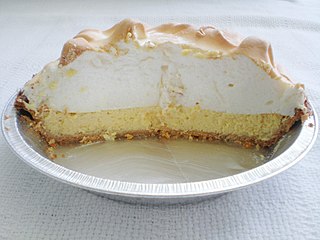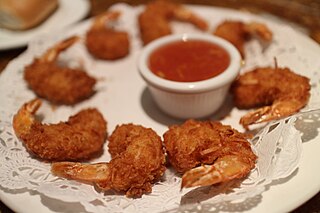Related Research Articles

Fish sauce is a liquid condiment made from fish or krill that have been coated in salt and fermented for up to two years. It is used as a staple seasoning in East Asian cuisine and Southeast Asian cuisine, particularly Myanmar, Cambodia, China, Indonesia, Laos, Malaysia, Philippines, Taiwan, Thailand, and Vietnam. Some garum-related fish sauces have been used in the West since the Roman times.

Calamansi, also known as calamondin, Philippine lime, or Philippine lemon, is an economically important citrus hybrid predominantly cultivated in the Philippines. It is native to the Philippines, Borneo, Sumatra, and Sulawesi in Indonesia in Southeast Asia, as well as southern China and Taiwan in East Asia. Calamansi is ubiquitous in traditional Filipino cuisine. It is naturally very sour, and is used in various condiments, beverages, dishes, marinades, and preserves. Calamansi is also used as an ingredient in Malaysian and Indonesian cuisines.

Ceviche, also cebiche, seviche, or sebiche is a South American seafood dish originally from what is the modern day country of Peru, typically made from fresh raw fish cured in fresh citrus juices, most commonly lemon or lime. It is also spiced with ají, chili peppers or other seasonings and julienned red onions, salt, and coriander are also added. The name originates from the Quechuan word siwichi, which means fresh or tender fish.

Key lime pie is an American dessert pie. It is made of lime, egg yolks, and sweetened condensed milk. It may be served with no topping, topped with a meringue topping made from egg whites, or with whipped cream; it may be cooked in a pie crust, graham cracker crust, or no crust. The dish is named after the small Key limes, which are more aromatic than the common Persian limes, and which have yellow, not green, juice. The filling in a Key lime pie is also yellow, largely because of the egg yolks.

Dolma is a family of stuffed dishes associated with Ottoman cuisine, and common in modern national cuisines of regions and countries that once were part of the Ottoman Empire. Some types of dolma are made with whole vegetables, fruit, offal or seafood, while others are made by wrapping grape, cabbage, or other leaves around the filling. Wrapped dolma are known as sarma. They can be served warm or at room temperature.

Adobo or adobar is the immersion of cooked food in a stock composed variously of paprika, oregano, salt, garlic, and vinegar to preserve and enhance its flavor. The Portuguese variant is known as Carne de vinha d'alhos. The practice, native to Iberia, was widely adopted in Latin America, as well as Spanish and Portuguese colonies in Africa and Asia.

Chili sauce and chili paste are condiments prepared with chili peppers.

Adobada, also spelled adovada, is a preparation for many dishes that are common in Mexican cuisine similar to tacos. Adobada is generally pork marinated in a "red" chili sauce with vinegar and oregano, but it can refer to different types of meat and to marinades closer to al pastor. It is generally served on small, pliable corn maize tortilla along with sautéed vegetables and cheese.

Camaron rebosado is a deep-fried battered shrimp dish in Philippine cuisine. It is usually served with a sweet and sour sauce. It is a common dish in Philippine cuisine.

Bean dip is a type of dipping sauce made using beans or refried beans as a primary ingredient. It is typically served with tortilla chips, and can also be served with other foods such as crackers and crudités. Various types of beans are used, and fresh-cooked, canned or flaked beans can be used. Various additional ingredients are used in its preparation, such as onion, garlic, chili peppers and spices, and it is sometimes garnished with some ingredients. Bean dip can be served cold, at room temperature, or hot. Bean dip is sometimes used as an ingredient in the preparation of other dishes such as burritos and quesadillas.

Shirazi salad is an Iranian salad that originated from and is named after Shiraz in southern Iran. It is a relatively modern dish, dating to sometime after the introduction of the tomato to Iran at the end of the nineteenth century in the Qajar era. Its primary ingredients are cucumber, tomato, onion, olive oil, herbal spices and verjuice, although lime juice is sometimes used in its preparation. In Iran, it is eaten in the summer as a side dish on its own, and year-round as a side dish alongside meat-based foods such as kebab and as a side dish before and after meals. Shirazi salad is sometimes served as an accompaniment to rice such as loobia polo, an Iranian rice dish made with green beans and tomatoes. Cookbook author Jila Dana-Haeri describes it as a refreshing dish during the summer.

Sambal is a chilli sauce or paste, typically made from a mixture of a variety of chilli peppers with secondary ingredients such as shrimp paste, garlic, ginger, shallot, scallion, palm sugar, and lime juice. Sambal is an Indonesian loan-word of Javanese and Sundanese origin. It originated from the culinary traditions of Indonesia, and is also an integral part of the cuisines of Malaysia, Sri Lanka, Brunei and Singapore. It has also spread through overseas Indonesian populations to the Netherlands and Suriname.

Coconut shrimp is a shrimp dish prepared using shrimp and coconut as primary ingredients. It can be prepared as a crunchy dish with the shrimp coated and deep fried, pan-fried or baked, and as a sautéed dish using coconut milk and other ingredients. It can be prepared and served on skewers.
Crema is the Spanish word for cream. In the United States, or in the English language, it is sometimes referred to as crema espesa, also referred to as crema fresca in Mexico. Crema fresca or crema espesa is a Mexican dairy product prepared with two ingredients, heavy cream and buttermilk. Salt and lime juice may also be used in its preparation. Crema's fat content can range between 18 and 36 percent. In Mexico, it is sold directly to consumers through ranches outside large cities, as well as being available in Mexican and Latino grocery stores in the United States. Crema is used as a food topping, a condiment and as an ingredient in sauces. It is similar in texture and flavor to France's crème fraîche and sour cream.

Avocado soup is a fruit soup prepared using avocados as a primary ingredient. Ingredients used in its preparation in addition to ripe avocados can include milk, cream, half-and-half or buttermilk, soup stock or broth, water, lime juice, lemon juice, salt and pepper. Additional ingredients used can include onions, shallots, garlic, hot sauce, cilantro, red pepper, cayenne pepper and cumin, and water can be used to thin the soup. It is enjoyed widely in areas of Mexico as a classic dish.

Garlic sauce is a sauce prepared using garlic as a primary ingredient. It is typically a pungent sauce, with the depth of garlic flavor determined by the amount of garlic used. The garlic is typically crushed or finely diced. Simple garlic sauce is composed of garlic and another ingredient to suspend the bulb via emulsion, such as oil, butter or mayonnaise. Various additional ingredients can be used to prepare the sauce.
References
- 1 2 Gassenheimer, L. (2010). The Flavors of the Florida Keys. Grove/Atlantic, Incorporated. p. 121. ISBN 978-0-8021-9623-1 . Retrieved June 7, 2017.
- 1 2 Zanger, M. (2001). The American Ethnic Cookbook for Students . Cookbooks for Students. Oryx Press. p. 33. ISBN 978-1-57356-345-1 . Retrieved June 7, 2017.
- 1 2 "Old Sour recipe".
- ↑ Fussell, Betty. "Old Sour Recipe". NYT Cooking. Retrieved 7 June 2017.
- ↑ "FAMOUS KEY WEST RECIPES". key-west.com. Retrieved 7 June 2017.
- ↑ Young, Joyce LaFray, The Key Lime Cookbook, The Ketch & Yawl Press, 2007, p 32
- 1 2 "cooking.com by Hoffman Media". www.cooking.com. Retrieved 7 June 2017.